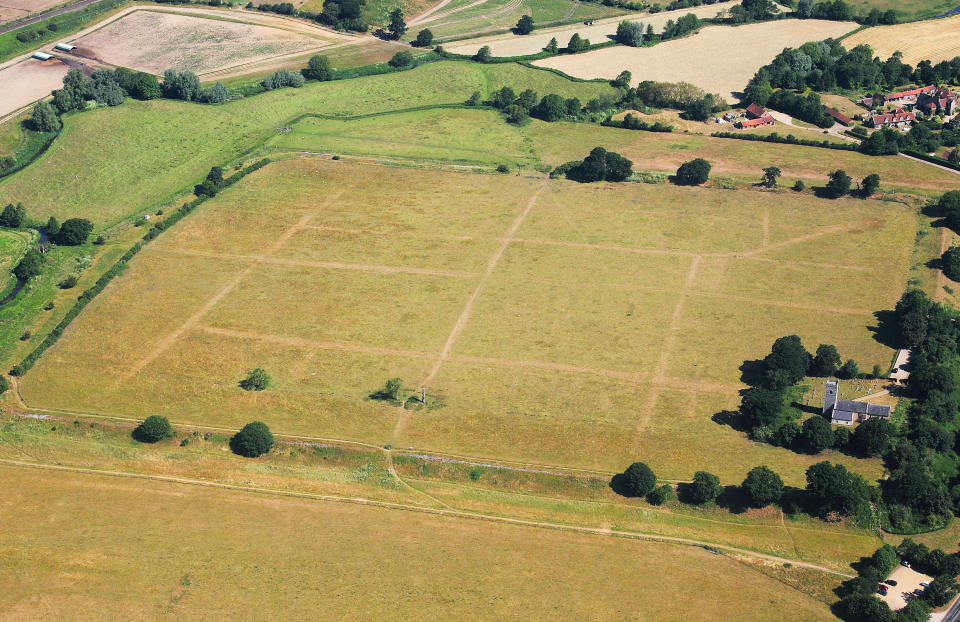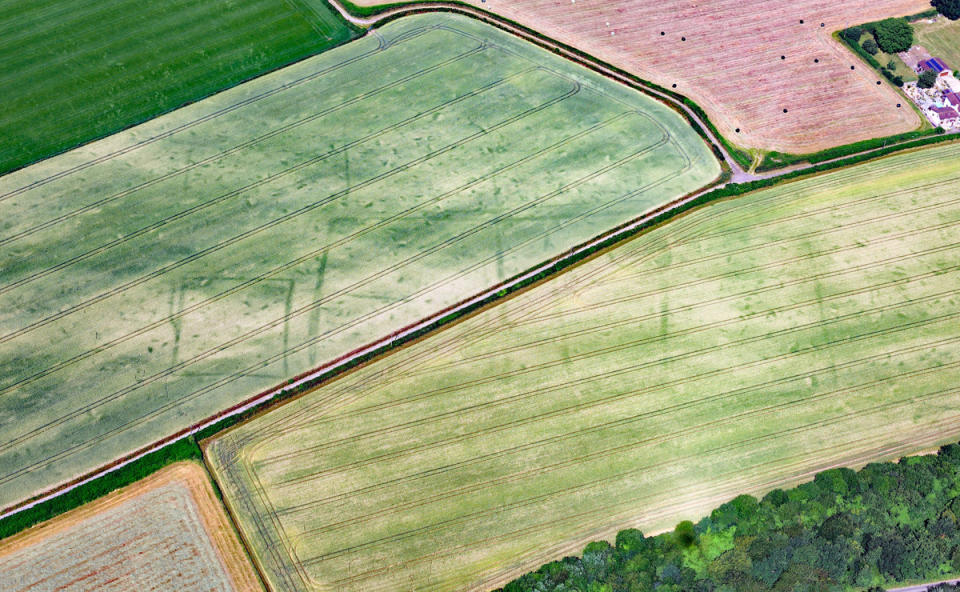Outlines of thousand-year-old historic sites appear in British fields due to heatwave

The UK’s heatwave has exposed ancient secrets and lost wonders.
Scorched fields and hillsides have uncovered the outlines of a first century town, a ‘ghost garden’ from the 1850s and a World War Two airfield have all appeared as the normally luscious green landscape turns brown.
The parched land has been caused by Britain’s longest heatwave since 1976, which has included the hottest June on record.
Photographer Mike Page snapped images from high above the Norfolk countryside to take a photo of Caistor Roman Town – which was founded in AD60 as the Roman predecessor of the modern county town of Norwich.
The site, which resembles an assorted collection of football pitches, was first discovered by an RAF aircraft in July 1928 and is only visible in extremely hot summers.
Staff at National Trust Gawthorpe, Lancs, meanwhile, were stunned to see clearly the outline of a garden that was installed in the 1850s but removed after the Second World War.


The ‘ghost garden’, which was designed by Sir Charles Barry, the same man who sketched out plans for the Houses of Parliament in Westminster, has been visible during particularly hot summers in the past.
The garden’s outline has never been seen this clearly, though, according to Gawthorpe Hall museum manager Rachael Tollitt.
She said: “There has been a real positive reaction from locals who may not have thought about the garden before. We’ve had a lot of interest from people wanting to know about the garden in person and on social media.”
Photographer Jordan Bridge, meanwhile, was able to get up above Lasham Airfield in Hampshire to capture an incredible photo showing the outline of the site when it was much bigger in WW2.

Mr Bridge said: “My photos are unique as they were captured from the air by a glider, and unlike other cropmarks these are in huge detail as they are from recent history.
“I am no archaeologist or land expert though, just a professional glider pilot!”
The De Havilland Mosquitos took off from the airfield during the war, and took part in the heroic air raids of April 1944 when 613 Squadron bombed the Central Records Registry of the Gestapo in the Hague, Netherlands.
Dr Toby Driver, 48, archaeologist and senior investigator at the Royal Commission on the Ancient and Historical Monuments of Wales, said aerial footage they took of the excoriated Welsh countryside on Friday (july6) even unearthed some previously unknown sites.
Dr Driver said: “There has been such an extreme drought we’ve got sites of national significance emerging.”

The crop marks photographed at Langstone are one of the commission’s new discoveries, which have been found in the same area as an already-discovered Roman fortification.
Dr Driver said: “It’s a race against time now to find out the significance of this new discovery . Those marks will probably only be there for another two-and-a-half weeks or so.”
MOST POPULAR TODAY ON YAHOO
What it really means when you smell chlorine at the pool (and five other vile gym facts)
Theresa May future in jeopardy as David Davis quits over Prime Minister’s handling of Brexit
Amesbury Novichok poisoning: Murder probe launched following death of woman exposed to nerve agent
Open plan offices ‘are a really bad idea’, scientists conclude
Baking Britain: Heatwave in pictures as UK melts after ‘second driest June ever’
Another previously undiscovered Roman site near Magor, south Wales has been unearthed by the commission’s aerial footage.
Other shots taken from the Cessna Aircraft include the nearly dried-up Nant-y-Moch reservoir and the Gaer Fawr hillfort, both in Ceredigion, Wales.
The hillfort, according to Dr Driver, has not been seen for 30 years.

 Yahoo News
Yahoo News 
